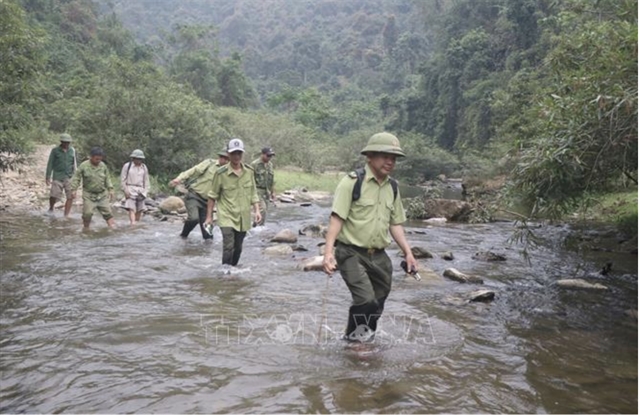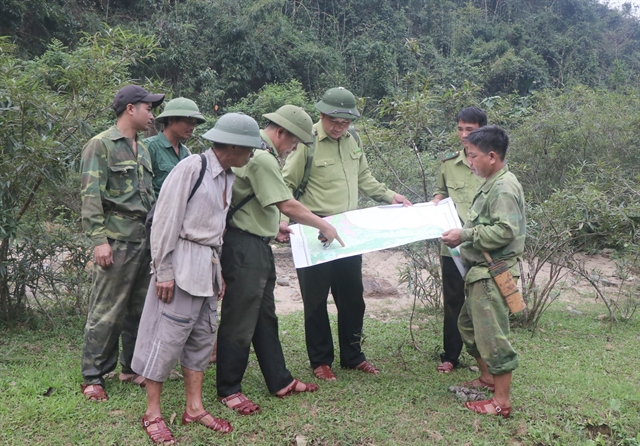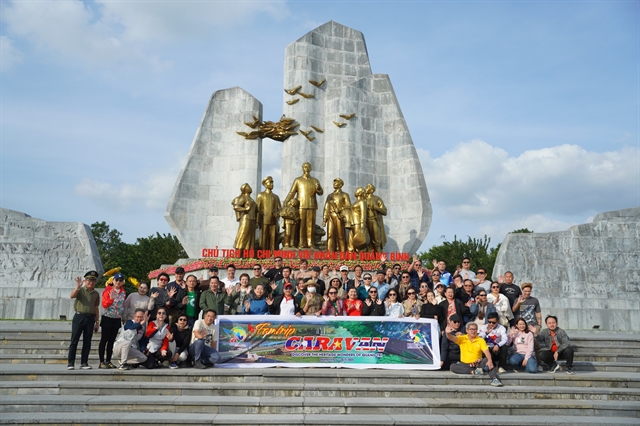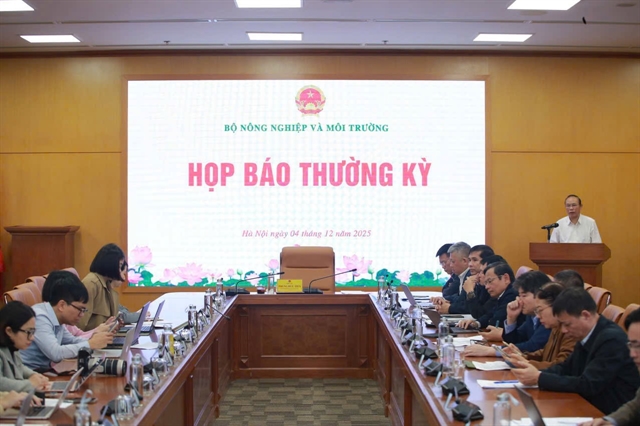 Environment
Environment

 |
| Rangers of Nga My Forest Protection Station in Nghệ An Province on patrol in Pú Huống Forest. VNA/VNS Photo Xuân Tiến |
NGHỆ AN – Every week, regardless of heat or cold, forest rangers conduct patrols in the ethnic hamlets of Canh, Xốp Kho, Na Ngân and Na Kho, in the isolated core area of Pù Huống Nature Reserve in Nghệ An Province.
Rangers travel dirt paths by foot to reach the core area of the huge forest.
According to Nguyễn Viết Phòng, deputy manager of Nga My Forest Protection Station, there are six villages of two communes, Nga My and Xiêng My, located in the core of the reserve area, populated by the Thai ethnic minority, most of whom are poor.
The people live mainly on farming, animal husbandry and forests, so special-use forests have always been under pressure and risk of encroachment.
“Forest patrol and inspection is the main task of the station, to detect and promptly prevent acts affecting forest resources such as cutting down trees for farming, encroaching on forest land, and hunting or trapping wild animals,” Phòng said.
“Pù Huống Forest has rugged terrain, with many deep streams and steep mountains, making patrolling very difficult,” he said.
To reach the villages of the Thai ethnic group, there are only narrow dirt paths with steep slopes and crossing deep pools, running along the sides of Pù Hiếng Mountain under the canopy of deep forests.
The most dangerous sections are so narrow they only allow one person to pass along the rocks, so people have to be very careful.
 |
| A GPS device is used in forest management. VNA/VNS Photo Xuân Tiến |
Trịnh Duy Hưng, a ranger of Nga My Forest Protection Station, said: "Some patrols last from 3 to 5 days. On these we must be self-sufficient, sleeping, living and eating within the strenuous conditions.”
“When we go on forest patrols, we have to bring food, drinks, medicine and necessary items. Patrols become even more difficult and dangerous because of rain, hail, thunderstorms and floods,” said Hưng.
“Sleeping in the forest at night is very cold, we have to do exercises to warm up and use repellent to prevent insect attacks,” he said.
“There were many trips that took a long time, we had to be frugal and share what little food we had left,” he said.
“To do this work, you have to really love the forest and the job to ‘stay with the forest’ and complete such trips," he said.
Fortunately, in recent years, other functional forces, local authorities and people have accompanied and joined hands to effectively protect the Pù Huống Forest - one of the three core areas of the Western Nghệ An Biosphere Reserve.
 |
| Forest rangers and local people during a patrol in Pù Huống Forest. VNA/VNS Photo Xuân Tiến |
Bùi Hữu Sỹ, manager of Nga My Forest Protection Station said that the station was assigned to manage the core area of Pù Huống Nature Reserve including 16 sub-areas of more than 15,360ha in 2 communes, Nga My and Xiêng My.
The special-use forest managed by Nga My Forest Protection Station is adjacent to the protective forest of Yên Tĩnh Commune of Tương Dương District, the special-use forest of Diễn Lãm and Châu Hoàn communes of Quý Châu District, Quang Phong Commune of Quế Phong District, and Bình Chuẩn Commune of Con Cuông District.
This is an area with many areas of old-growth forests and the unique ecosystem of the northern Trường Sơn Range, with a high diversity of flora and fauna and many endangered and rare species, it is also an important link in the Pù Huống special-use forest ecosystem connecting with Pù Mát National Park and Pu Hoạt Nature Reserve that form the green belt of western Nghệ An Biosphere Reserve, according to the manager.
Joining hands to protect the forest
Pù Huống Nature Reserve, recognised by UNESCO as a World Biosphere Reserve in September 2007, covers more than 46,460ha spreading over 15 communes in five mountainous districts of Nghệ An Province, which includes more than 40,000ha of special-use forests.
There are nearly 570 animal species living in the forest, including 69 species in the Việt Nam Red Book, 51 species in the Red List of the International Union for Conservation of Nature (IUCN) in 2020 and 36 species in the CITES Convention.
There are more than 1,800 plant species, including 76 species in the Việt Nam Red Book and 15 species in the IUCN Red List 2020.
The Pù Huống Forest currently has reached more than 98 per cent coverage and its vegetation ecosystem is typically characterised by two types - subtropical low mountain forests and closed evergreen tropical rain forests.
The forest is very diverse in habitat, biology, and species richness including valuable trees including green ironwood, fokienia, ebony and Nageia fleuryi and rare animals such as red-faced monkey, bordered mountain turtle, white pheasant, loris, pure black gibbon, silver-cheeked black gibbon, grey langur and star pheasant.
Sỹ said that recently, the station and the authorities of Nga My and Xiềng My communes had implemented plans and solutions to protect the reserve such as increasing numbers of forest patrols and promoting people’s awareness of forest fire prevention and control, preventing acts of forest encroachment, and strictly prohibiting and suppressing all types of crimes related to weapons, explosives, trading and transporting forest products, and hunting and trapping rare animals.
“In difficult, strenuous conditions and pressure from the customs and practices of indigenous people, the station's rangers always stick to the forest and ethnic villages to raise awareness in forest management and protection work for people, especially communities living in special-use forest buffer zones, deploying forestry programmes and policies by the Party and State to help people improve their lives,” Sỹ said.
“People's awareness of forest protection has clearly increased over the past many years. They understand the role and importance of forests and always accompany and join hands with forest rangers in managing and protecting forests,” he added.
Vi Văn Hải, a resident of Xốp Kho Hamlet in Nga My Commune, said that the hamlet currently had 10 forest management and protection groups established and provided with equipment such as firefighting tools to use when a fire occurs.
People in the hamlet always had forest rangers to disseminate the Forestry Law and teach fire prevention and control skills, Hải said.
Ngân Văn Trọng, head of Khe Quỳnh Hamlet of Xiêng My, said that the people in the hamlet were always aware that protecting the forest is very important, and strictly comply with the regulations of not cutting trees or hunting animals in the forest, and absolutely would not use fire in the forest during the hot, dry season.
Lương Tuấn Dũng, chairman of the Nga My People’s Committee, said that local authorities always accompanied forest rangers and owners in forest protection patrols and implemented forestry projects in the Pù Huống Nature Reserve to create sustainable livelihoods for the ethnic people.
Additionally, the authorities enhanced measures to control and prevent illegal hunting and trapping of wild animals and prevent forest fire, as well as guide people to produce in areas where crop rotation is allowed, the chairman said. VNS




